

|
| UNITED STATES OF AMERICA | |
| NEW JERSEY | |
| Atlantic County |
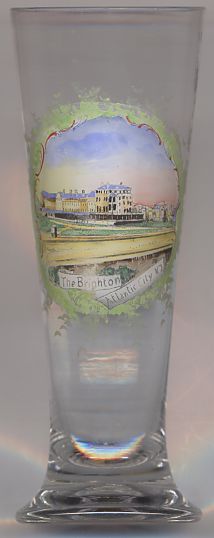 Atlantic City is situated on Absecon Island, off the Atlantic Ocean coast of Atlantic County in southeastern
New Jersey. As of the United States 2000 Census, the city population was 40,517.
Atlantic City is situated on Absecon Island, off the Atlantic Ocean coast of Atlantic County in southeastern
New Jersey. As of the United States 2000 Census, the city population was 40,517.
Early South Jersey settlers had largely ignored the island as access was only by boat across six miles of bay and salt marshes from the mainland. In 1852, the local area physician Dr. Jonathan Pitney envisioned a ‘bathing village and health resort’ and joined a group of businessmen who wanted to develop South Jersey and received a railroad charter for a line from Camden to Atlantic City. The town was designed and named by engineer Richard Osborne. Already two years later, the town was incorporated and the first train from Camden arrived. As Atlantic City was located near to population centers and the trains offered convenient and inexpensive access, the city soon grew rapidly into a popular sea resort. In the 1920’s it was a pre-Broadway tryout town. Population peaked in the 1930’s. In the 1940’s the U.S. Army used the city for training purposes, occupying several of the major hotels. Atlantic City’s popularity declined in the 1950’s when air travel to vacation places in Florida and the Caribbean became more widely available. Gambling was legalized in the city in 1976 as a „unique tool of urban development“. After the first casino opened in 1978 the development of the city indeed changed dramatically. By 1988, already a dozen casinos were operating and in 1990 more than 30 million people visited the city.
The  Brighton Hotel [left] was one of the first exclusive hotels in Atlantic City, the first in the city to entertain guests
year round. Many times, the hotel was extendended and modernized. In 1894, the hotel opened the Brighton Casino on the ocean front.
Brighton Hotel [left] was one of the first exclusive hotels in Atlantic City, the first in the city to entertain guests
year round. Many times, the hotel was extendended and modernized. In 1894, the hotel opened the Brighton Casino on the ocean front.
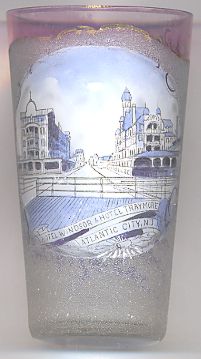
The  Traymore Hotel [near left, no. 2419: on the left]
was one of the earliest of the classic Atlantic City Boardwald hotels.
The Traymore began in 1879 as a beachfront, 10-room wooden cottage at Illinois Ave. and the Boardwalk.
The first Traymore "hotel" was more of a bath house than a full-service hotel, and it was, evidently, quite flimsy:
on January 10, 1884, a fierce winter storm savaged the Boardwalk and reduced the Traymore to splinters, while the
adjacent Park Parlors was left intact. The Traymore was quickly rebuilt and was continually enlarged until, in 1898,
it became the city’s largest hotel, with 450 rooms. The Traymore continued to grow.
The picture on glass no. 2419 shows a view of that period.
During the summer of 1914,
plans for a new, massive concrete structure were drawn up. The new Traymore was built directly behind the 1906 tower
and was designed to take advantage of its ocean views: hotel wings jutted out further from the central tower toward
Pacific Avenue, thus affording more guests ocean views. Commencing just after Labor Day, construction crews worked
non-stop to erect the new Traymore in time for the 1915 season. Building during the winter months had been made
possible by John Murtland whose National Supply Company furnished sand and gravel already heated for mason work.
Built with tan brick and capped by yellow-tiled domes, the Traymore instantly became the city’s architectural
showpiece when it opened in June 1915. A further 40-story tower addition was not built because of problems securing
financing during World War I. If it had been built, this building would still be the tallest in Atlantic City.
In 1924 the Traymore was described as "the Taj Mahal of Atlantic City," decades before Donald Trump opened a casino
resort with that name. But as Atlantic City declined in the 1960s, the Traymore did as well. By the early 1970s,
the hotel was defunct and was slated for demolition, despite a campaign to save this architectural landmark. Even
in its destruction, the Traymore was outstanding. To this day, the once-famous Atlantic City hotel still holds the
Guinness World Record for largest controlled demolition—with a capacity of nearly 6.5 million cubic feet, the Traymore
is the largest (though not highest) structure yet demolished.
Traymore Hotel [near left, no. 2419: on the left]
was one of the earliest of the classic Atlantic City Boardwald hotels.
The Traymore began in 1879 as a beachfront, 10-room wooden cottage at Illinois Ave. and the Boardwalk.
The first Traymore "hotel" was more of a bath house than a full-service hotel, and it was, evidently, quite flimsy:
on January 10, 1884, a fierce winter storm savaged the Boardwalk and reduced the Traymore to splinters, while the
adjacent Park Parlors was left intact. The Traymore was quickly rebuilt and was continually enlarged until, in 1898,
it became the city’s largest hotel, with 450 rooms. The Traymore continued to grow.
The picture on glass no. 2419 shows a view of that period.
During the summer of 1914,
plans for a new, massive concrete structure were drawn up. The new Traymore was built directly behind the 1906 tower
and was designed to take advantage of its ocean views: hotel wings jutted out further from the central tower toward
Pacific Avenue, thus affording more guests ocean views. Commencing just after Labor Day, construction crews worked
non-stop to erect the new Traymore in time for the 1915 season. Building during the winter months had been made
possible by John Murtland whose National Supply Company furnished sand and gravel already heated for mason work.
Built with tan brick and capped by yellow-tiled domes, the Traymore instantly became the city’s architectural
showpiece when it opened in June 1915. A further 40-story tower addition was not built because of problems securing
financing during World War I. If it had been built, this building would still be the tallest in Atlantic City.
In 1924 the Traymore was described as "the Taj Mahal of Atlantic City," decades before Donald Trump opened a casino
resort with that name. But as Atlantic City declined in the 1960s, the Traymore did as well. By the early 1970s,
the hotel was defunct and was slated for demolition, despite a campaign to save this architectural landmark. Even
in its destruction, the Traymore was outstanding. To this day, the once-famous Atlantic City hotel still holds the
Guinness World Record for largest controlled demolition—with a capacity of nearly 6.5 million cubic feet, the Traymore
is the largest (though not highest) structure yet demolished.
[Text adapted from http://www.casinoconnectionac.com/articles/The_Biggest_and_Brightest, http://nj-files.biofiles.us/SJersey-481-500.pdf]
The building depicted on the right on glass no. 2419 is the
 Windsor
Windsor
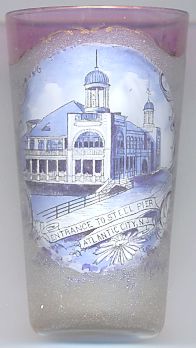
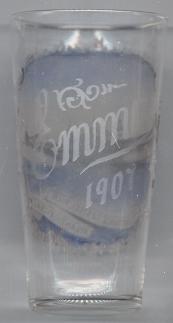
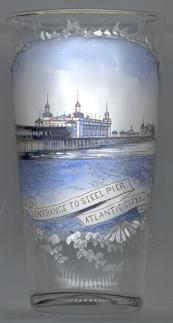
The historic  Steel Pier [naer left, no. 2376, and right, no. 942] originally opened in 1898 and quickly became known for showcasing the world’s top entertainers. From the 1920’s to the 1950’s
all great entertainers played Steel Pier. With the decline of Atlantic City in the 1950’s the glory of Steel Pier slowly faded away, and it eventually closed in 1976.
After years of neglect, the original Steel Pier was finally destroyed by a devastating fire in 1982. However, in 1993 Steel Pier was rebuilt by Donald Trump’s Taj Mahal,
making the pier a centerpiece of family entertainment once again.
Steel Pier [naer left, no. 2376, and right, no. 942] originally opened in 1898 and quickly became known for showcasing the world’s top entertainers. From the 1920’s to the 1950’s
all great entertainers played Steel Pier. With the decline of Atlantic City in the 1950’s the glory of Steel Pier slowly faded away, and it eventually closed in 1976.
After years of neglect, the original Steel Pier was finally destroyed by a devastating fire in 1982. However, in 1993 Steel Pier was rebuilt by Donald Trump’s Taj Mahal,
making the pier a centerpiece of family entertainment once again.
The inscription on the back of the glass no. 942 reads "Emma, 1907".
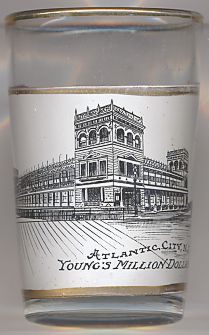
 Young’s Million Dollar Pier [near left, no. 2202] was built in 1906 by Captain John L. Young.
The attractions included a ballroom, a course used for horse shows, a replica of a Greek temple, exhibition space, and a series of aquariums.
Million Dollar Pier hosted the first Miss America Pageants, Sarah Bernhardt’s first Atlantic City concert, and scores of big
bands, vaudeville acts, and dance marathons. For younger guests, attractions included carnival games and thrill rides. Despite its popularity, the pier, like much of Atlantic City,
suffered through a period of decline. By the time the city’s first casino opened in 1978, it was literally a shell of its former self. In 1981 plans were announced to demolish the
old wooden pier and replace it with a concrete and steel edifice to be called 'Ocean One'. The new pier included three decks of stores, restaurants with ocean views, and a top-deck
miniature golf course. Unfortunately, it proved less durable than Young’s original, and before it reached its 20th birthday, it was consigned to the scrap heap.
In 2002 new plans were announced to redevelop the pier which now operates as 'Pier at Caesars'.
Young’s Million Dollar Pier [near left, no. 2202] was built in 1906 by Captain John L. Young.
The attractions included a ballroom, a course used for horse shows, a replica of a Greek temple, exhibition space, and a series of aquariums.
Million Dollar Pier hosted the first Miss America Pageants, Sarah Bernhardt’s first Atlantic City concert, and scores of big
bands, vaudeville acts, and dance marathons. For younger guests, attractions included carnival games and thrill rides. Despite its popularity, the pier, like much of Atlantic City,
suffered through a period of decline. By the time the city’s first casino opened in 1978, it was literally a shell of its former self. In 1981 plans were announced to demolish the
old wooden pier and replace it with a concrete and steel edifice to be called 'Ocean One'. The new pier included three decks of stores, restaurants with ocean views, and a top-deck
miniature golf course. Unfortunately, it proved less durable than Young’s original, and before it reached its 20th birthday, it was consigned to the scrap heap.
In 2002 new plans were announced to redevelop the pier which now operates as 'Pier at Caesars'.
[Text adapted from http://www.casinoconnection.com/articles/Million-Dollar_Memories]
![[scale]](lineal.jpg)